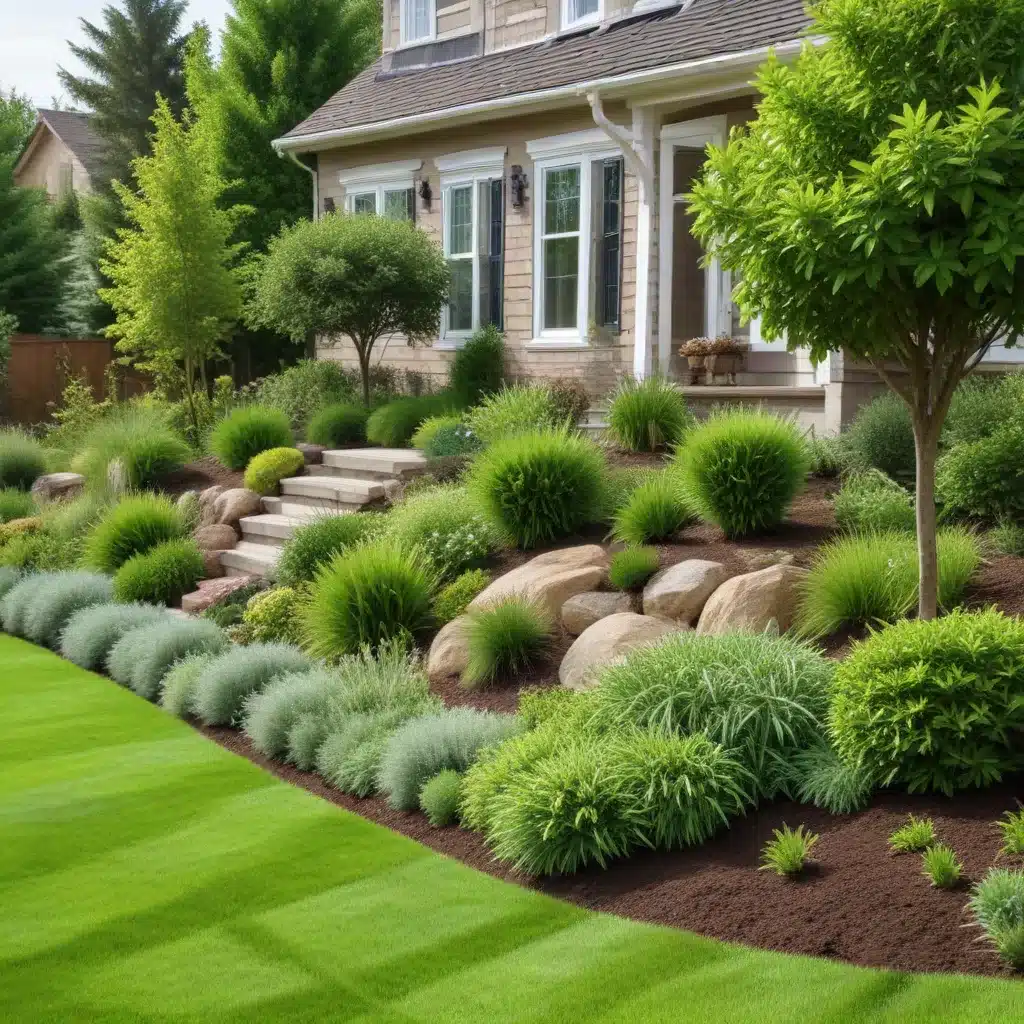
As an experienced home improvement consultant, I’ve seen firsthand how a thoughtful, sustainable approach to landscaping can elevate any eco-friendly home renovation. Whether you’re looking to reduce your environmental impact, lower utility bills, or create a lush, inviting outdoor space, sustainable landscaping offers a wealth of benefits that extend far beyond mere aesthetics.
Xeriscape Gardening Principles
At the heart of sustainable landscaping lies the concept of xeriscaping – the practice of selecting drought-tolerant, native plants that thrive in the local climate with minimal water and maintenance requirements. By embracing xeriscape principles, you can dramatically reduce your reliance on precious water resources while cultivating a vibrant, low-maintenance garden.
Start by conducting a soil analysis to determine the optimal plant selections for your property. Native species like Texas Lantana, Texas Kidneywood, and Texas Bluebonnet are not only hardy and resilient but also attract pollinators and support local biodiversity. Complementing these native plants with groundcovers like Ajuga, Lilyturf, and Frogfruit can further minimize the need for water-intensive turf grass.
Native Plant Selection
Going beyond just drought tolerance, native plants offer a wealth of benefits that can enhance your overall eco-friendly home renovation. These species have naturally adapted to the local ecosystem, requiring fewer inputs like fertilizers and pesticides to thrive. By incorporating native plants into your landscape, you’ll reduce your carbon footprint, support local wildlife, and create a visually stunning, low-maintenance oasis.
Water-Efficient Irrigation
Conserving precious water resources is a crucial aspect of sustainable landscaping. Drip irrigation systems and rain gardens can be particularly effective in this regard. Drip irrigation delivers water directly to plant roots, minimizing waste from evaporation and runoff, while rain gardens divert stormwater away from your home’s foundation and recharge groundwater supplies.
For hardscaping elements like walkways and patios, consider permeable pavers that allow rainwater to seep into the ground, reducing runoff and promoting groundwater recharge. Pair these with a layer of organic mulch around plants and trees to further reduce evaporation and maintain healthy soil.
Eco-Friendly Building Materials
Sustainable landscaping extends beyond just plant selection and irrigation strategies. The materials you choose for your hardscaping features can also significantly impact the environmental footprint of your home renovation.
Sustainable Hardscaping Options
Look for recycled concrete, reclaimed bricks or stones, and permeable pavers made from sustainable materials like recycled plastic or porous concrete. These options not only reduce waste but also enhance the overall aesthetic of your outdoor living spaces.
Recycled and Reclaimed Materials
Incorporating recycled glass, plastic, or steel elements into your landscape design can add unique character while reducing the demand for new resources. Repurposed materials like reclaimed wood or salvaged architectural features can also infuse your outdoor spaces with a touch of rustic charm.
Green Roofing Systems
For the ultimate in eco-friendly landscaping, consider installing a green roof – a roof partially or completely covered with vegetation. Green roofs not only insulate your home, reducing energy costs, but also support enhanced biodiversity and stormwater management.
Biodiversity and Habitat Conservation
Sustainable landscaping plays a vital role in promoting biodiversity and creating wildlife-friendly habitats. By carefully selecting plant species that attract pollinators like bees and butterflies, you can support the health of local ecosystems while enjoying the vibrant colors and soothing sounds of nature.
Pollinator-Friendly Plantings
In addition to your native plant selections, incorporate flowering species that provide nectar and pollen sources for pollinators. This not only enhances the visual appeal of your landscape but also contributes to the overall ecological balance of your property.
Stormwater Management Strategies
Thoughtful stormwater management techniques like rain gardens and permeable hardscaping can help reduce the risk of flooding and erosion while recharging groundwater supplies. By designing your landscape to capture and infiltrate rainwater, you’ll be doing your part to protect local waterways and minimize the strain on municipal drainage systems.
Wildlife-Friendly Landscapes
Create a haven for local wildlife by incorporating features like birdhouses, bat boxes, and small ponds. These elements not only provide shelter and water sources but also contribute to the overall biodiversity of your outdoor spaces.
Energy-Efficient Home Design
Sustainable landscaping can also play a vital role in enhancing the energy efficiency of your home, resulting in lower utility bills and a smaller carbon footprint.
Passive Solar Orientation
Carefully positioning trees, shrubs, and other landscape elements can help harness the power of the sun to warm or cool your home naturally. By strategically placing deciduous trees on the south and west sides of your home, you can provide cooling shade in the summer while allowing sunlight to heat your home in the winter.
Landscape Shading Techniques
In addition to strategic tree placement, climbing vines and trellises can be used to shade windows and walls, reducing the heat load on your home and minimizing the need for air conditioning. Incorporating green roofs and green walls can also provide an extra layer of insulation, further enhancing your home’s energy efficiency.
Renewable Energy Integration
Your sustainable landscaping can even be integrated with renewable energy sources, such as solar panels. By positioning your landscape elements to optimize the placement and efficiency of solar arrays, you can maximize the energy-generating potential of your property.
As an experienced home improvement consultant, I hope this article has inspired you to explore the many benefits of sustainable landscaping for your eco-friendly home renovation. By embracing xeriscape gardening, native plant selection, water-efficient irrigation, and energy-efficient design strategies, you can create a beautiful, low-maintenance outdoor oasis that benefits both your wallet and the environment.
Remember, sustainable landscaping is not just about aesthetics – it’s about making a tangible difference in how we interact with and preserve our natural resources. So why not get started on your Reluctant Renovator project today? Your home, your wallet, and the planet will thank you.



